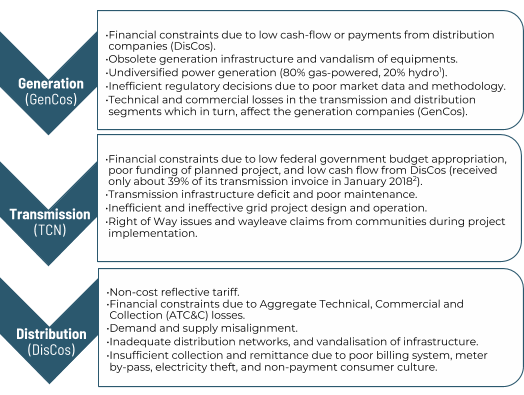This Memo was drafted in collaboration with Patrick Okigbo of Nextier Advisory
Context: Nigeria is Africa’s largest economy, but also has one of the widest energy gaps in the world. With a quickly growing population, Nigeria urgently needs to improve its power sector. The country’s current installed capacity is reported at 12,500 megawatts, but in practice is only 3,200 megawatts. The government’s aim to boost electricity access from 45% today to 90% by 2030 will drive even more demand. The government privatized part of the power sector in 2013 hoping to promote efficiency, attract private investment, and increase generation, but this has yet to deliver results.
1. Attract investment to the energy sector
- Conduct power asset inventory and audit to determine priority investment needs across the value chain and funding to replace or repair assets.
- Resolve long standing government liabilities to the electricity sector and create fiscal rules for future payments to prevent debt buildup.
- Increase the capital allocation for the Transmission Company of Nigeria (TCN), including an analysis of its budget performance.
- Consider privatization of TCN.
2. Solve barriers in the gas-to-power value chain
- Launch a federal coordination mechanism covering gas supplies, generation, transmission, and distribution.
- Enforce existing penalties for payment default along the value chain.
3. Plan for renewable energy integration
- Complete development of the 14 planned solar plants.
- Invest in new grid infrastructure to facilitate integration of intermittent sources.
- Integrate mini-grids into DisCo networks to supply power to underserved areas.
4. Boost revenue collection to support DisCo viability
- Update tariff schedule to synchronize the payment expectations in the Multi-Year Tariff Order (MYTO) and the financing plans of GenCos, TCN and DisCos.
- Utilize data analysis to more effectively allocate available power.
- Invest in new IT systems for DisCos to enable revenue collection, management, and transparency.
- Conduct an independent assessment of the power sector value chain to ensure accurate estimation of costs for electricity delivery and tariff adjustments.
5. Understand demand to guide prioritization
- Study energy demand to determine customer profiles, as well as stranded capacity in load rejection to ensure data-driven planning and reduction in technical, commercial, and collections losses.
FIGURE 1: Problems in Nigeria’s Power Value Chain

Endnotes
